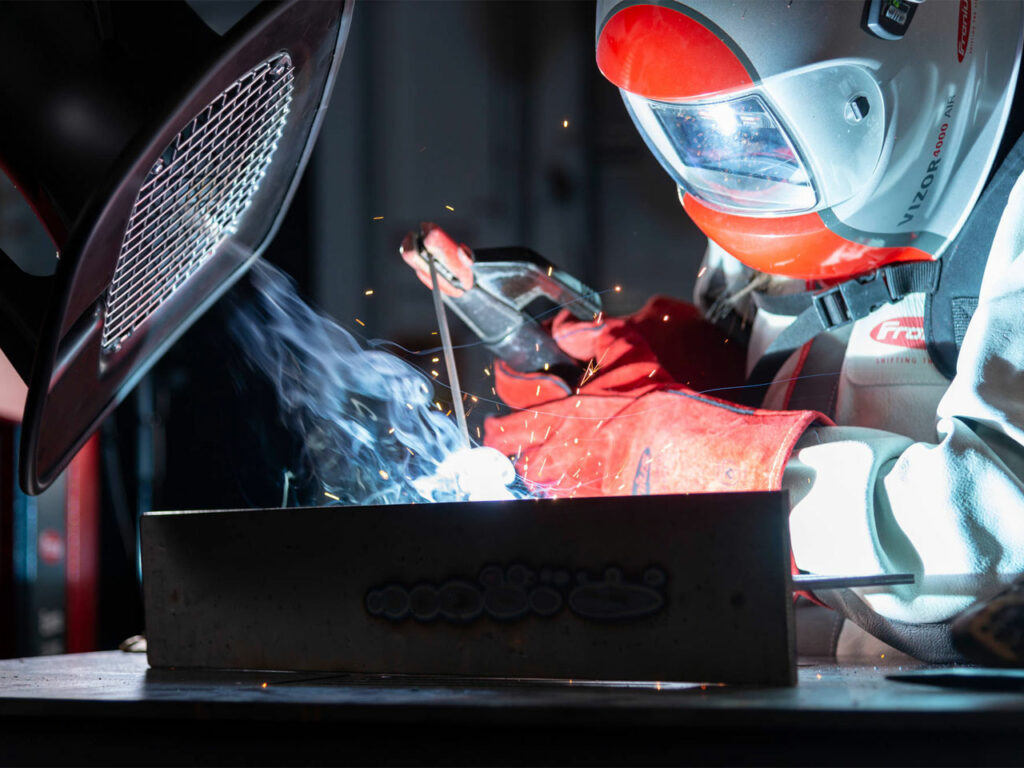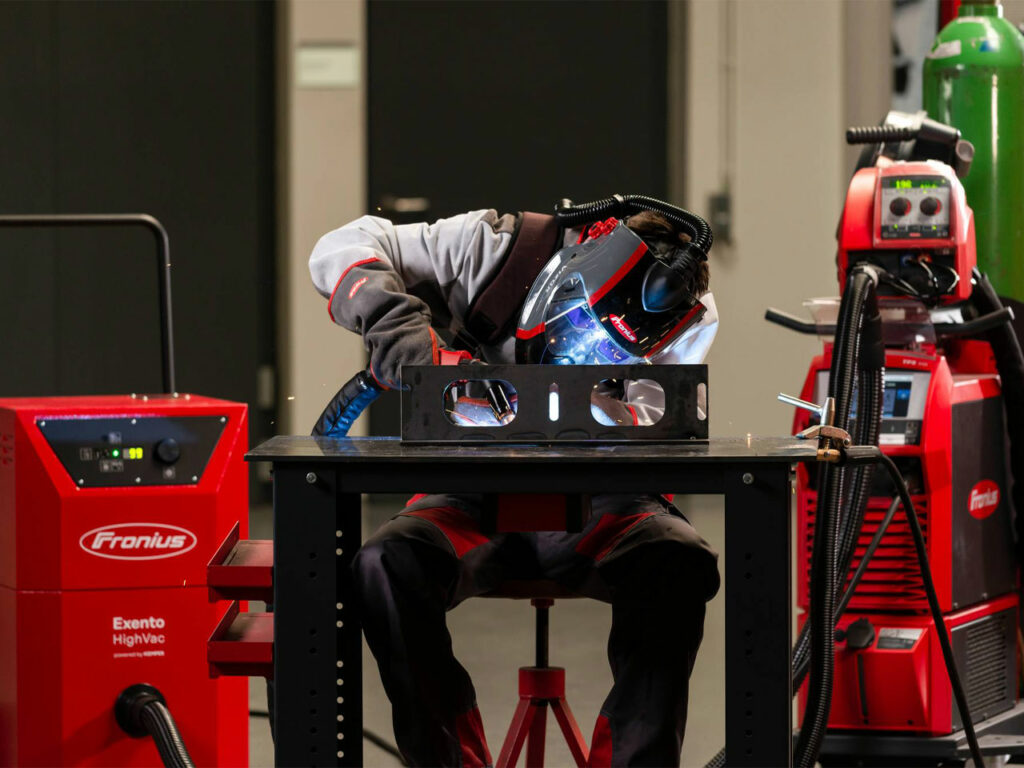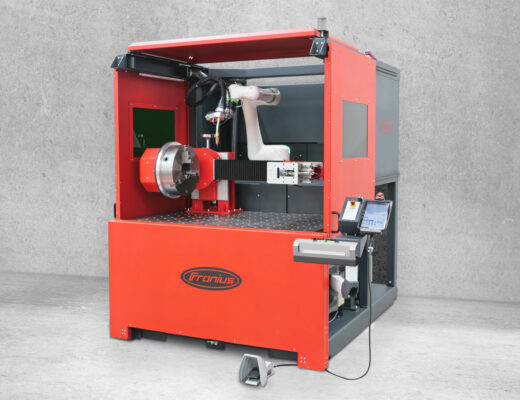It makes its way through the mouth and nose and into the smallest branches of the lungs – insidiously entering the body. “It” is welding fume. If you don’t use adequate protection, it spreads across the entire workshop and you breathe in the particles even when you’re not welding. So that’s the bad news. The good news is that targeted protective measures – first and foremost effective welding fume extraction – can significantly reduce exposure to welding fume. But what are the actual dangers of welding fume, why is a welding fume extraction system the best choice for optimum protection during welding, and what do you need to look for when choosing extraction products?
What is welding fume and what are its dangers?
Welding fume is among the greatest risks facing welders. In 2017, the WHO’s International Agency for Research on Cancer (IARC) classified it as “carcinogenic to humans” – underlining that the topic of welding fume protection deserves the utmost attention. When we talk about welding fume, we are referring to a mixture of gases and particles generated during welding. We distinguish between these substances as follows:
- Substances harmful to the respiratory tract and lungs, such as iron oxide, aluminum oxide, magnesium oxide, and titanium dioxide
- Toxic or toxic-irritating substances such as fluorides, manganese oxides, zinc oxide, carbon monoxide, nitrogen oxides, copper oxide, lead oxide, and ozone
- Carcinogenic substances such as chromium(VI) compounds, beryllium oxide, nickel oxides, and ozone
The principle reason why welding fume particles are so dangerous is their small size, which allows them to penetrate deep into the lungs. The fact that health problems caused by welding fumes often only become apparent years or even decades later makes them particularly treacherous. If welders are exposed to high concentrations of welding fume particles and do not adequately protect themselves, they may experience such symptoms as headaches and nausea in the short term. However, in the long term, welding fume exposure can result in chronic respiratory and lung diseases as well as damage to the nervous system or, in the worst case, even cancer.
What determines the harmful substance load in welding fume?
Several facts influence the volume of hazardous substances present in welding fume. These include the parent material as well as the filler metals – rod and wire electrode – and the shielding gas. The filler metals used generate the majority of the welding fume particles.
The various welding methods and processes themselves also have a significant influence on the harmful substances in welding fume. Manual arc welding and MIG/MAG welding, for example, generate more fumes than TIG welding, which is why particularly high levels of protection must be ensured here. The lowest health risk from welding fume arises in automated welding processes that are carried out in suitably equipped welding cells by robots – for example Cobot. Here, the protective enclosure with automatic anti-glare protection and the integrated extraction system also optimally protect those individuals around the welding cell from welding fume. Another option for reducing the risk posed by welding fume is to employ the CMT process (Cold Metal Transfer). This welding process is characterized by very low heat input and low amounts of welding spatter – and consequently also by the generation of fewer welding fumes.

The solution? Welding fume extraction
It is not always possible or desirable to change the welding method or process for various reasons. So the question is – what can you do as a welder to protect yourself from welding fume? There are several measures that are ideally always combined, including wearing a welding helmet with powered air-purifying respirator and implementing effective welding fume extraction by means of extraction systems and fume extraction torches. The latter in particular are highly effective in welding fume protection: when used in combination with extraction systems, they ensure precise extraction directly at the point where the welding fume is being generated. Welding fume is thus captured before it can spread at all – thereby protecting not only the welders themselves, but everyone else in the vicinity too.
Welding fume extraction systems: what’s important
Alongside maximum protection, welding fume extraction systems and extraction torches should offer one thing above all: ease of use. After all (as with other protective products) if they are unwieldy, impractical, and complicated, they are generally used less often. Which ultimately means less protection. As such, when selecting a welding fume extraction system, pay attention not only to the extraction capacity, but to convenience and ease of use too. That will allow you to concentrate fully on your welding work and remain well-protected at all times. When it comes to fume extraction torches, ergonomics are also vital. Their slightly larger design in comparison to conventional welding torches must not come at the expense of the health, safety, and performance of the welder.
Exento welding fume extraction systems from Fronius
Fronius Exento extraction systems satisfy all these requirements. They are powerful, compact, and easy to operate – delivering optimum protection against welding fume, whatever the application. The Exento HighVac mobile high-vacuum extraction system impresses with its particularly high filter quality, eliminating more than 99.9 percent of detected welding fume particles. When used in combination with the powerful, EN ISO 21904-1-compliant Exento fume extraction torch, it extracts the welding fume directly at the point of origin, thereby ensuring an especially high degree of protection. This extraction system is particularly well-suited to continuous use and – thanks to its compact design – to different workplaces.
In those cases where it is not possible to use a fume extraction torch (such as manual arc welding), the Exento LowVac low-vacuum extraction system is the perfect choice. It offers a decisive advantage when it comes to efficient work – thanks to the flow-optimized extraction hood design, significantly less extraction arm tracking is required than with conventional systems. Furthermore, the robust and stable design makes the Exento LowVac the perfect companion when frequent workplace changes are needed. Thanks to its high capacity and the long service life of the filter, the system is also exceptionally cost effective.
Would you like to find out more about the new Exento extraction products? Whether it’s greater freedom of movement, useful LED lighting, or different user interfaces – the new welding fume extraction systems offer numerous advantages that are guaranteed to help you choose the right system for your welding activities. Just take a look at our product page!

Health and safety – the top priority from start to finish in welding
The fact is, welding fume doesn’t have to be dangerous if you are properly protected. With the right measures and effective extraction products, you can reduce the risk of health hazards to a minimum. After all, health and safety comes first at all times in any profession – and welding is no exception. Over the next few months, we would like to use our special blog series to introduce you to other areas of protection, listen to voices from welding practice, and show you how you can optimally protect your health when welding. You can also find more detailed information on protection from welding fume in our welding fume study. Why not check it out today!
 Perfect Welding Blog
Perfect Welding Blog




3 Comments
Eli Richardson
26. December 2022 at 21:32It really helped when you elaborated on how to extract welding fumes and the importance of doing it for your health. Recently, my cousin mentioned he’s interested in starting a welding company in a few months, so he’s looking for the right equipment for the job, and I believe your insight will be key for his future operations. Thank you for the advice on choosing a welding fume extraction system that has the right extraction capacity.
James Smith
28. March 2023 at 13:05Welding fumes are very harmful. They can even cause cancer. so all welders must use fume extractor or even wear musk to avoid inhaling welding fume. Fumes are worse for lungs and respiratory system.
Thanks for the post
James Luther
26. December 2023 at 9:00Well explained, the blog is good and has everything you need to know. Welding fume extractors are indeed one of the most important equipment to have.